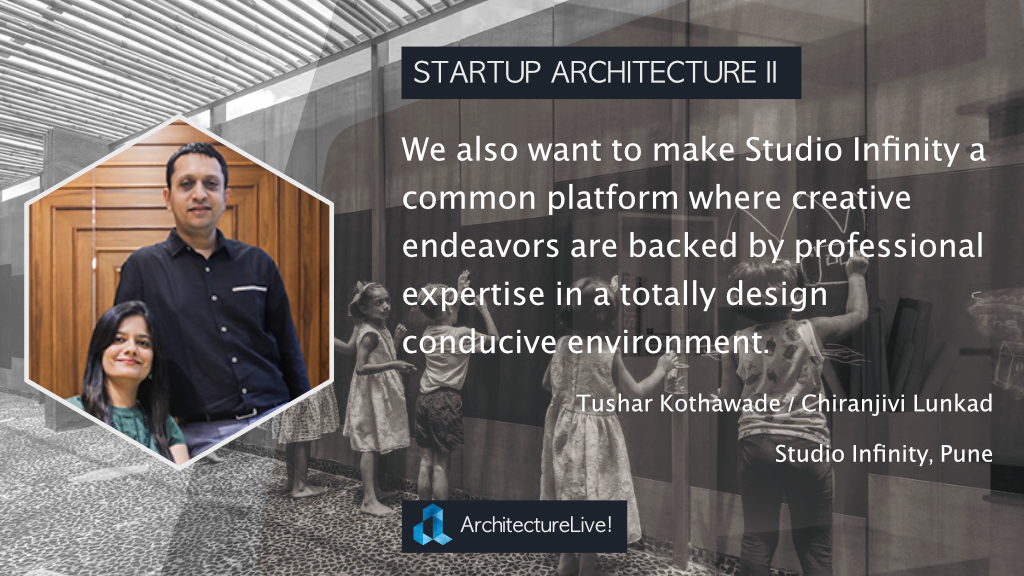A design studio based out of Pune, Studio Infinity was co-founded by Architect Tushar Kothawade and Designer Chiranjivi Lunkad in 2007 and later joined by Mahesh Talekar in 2012.
Since their early days at the design school, it has always been a dream of Ar. Tushar Kothawade and Chiranjivi Lunkad to start with their practice. After graduation, both of them worked with established design firms for about 6 years, before starting their own studio in Pune. “At that time our minds were full of ideas, anxiety, and hopes. The aspirations were immense and to be honest, we were hoping to make it big instantly (which didn’t happen though). Banking on our long enough experience of working on various projects, we for sure didn’t want to re-invent the wheel. Some basic do’s and don’ts were known and our clear intent was to explore wider avenues and reach new heights”, says Tushar.
Much like any new organization, the initial years have been full of challenges for Studio Infinity. The journey didn’t start the way they had imagined it to be.
“In the early days, we were facing hurdles at various layers of our practice. On one hand, we were struggling to get clients and on the other, we were going out of our way to set up a system to execute all those projects that were commissioned to us.”
Being in a city like Pune, the studio had to be flexible and open to accepting all sorts of jobs- architecture or interiors, small or medium, turnkey or only design. So, being able to provide end to end solutions was a key factor. Managing designs and site execution at the same time was equally important for the Studio. “We first started operating from our home, then shifted to a small out-house and finally 4 years later, to our current premises. So the initial phase proved to be challenging in more ways than one”, the struggle evident in their voices as they speak. But again, success isn’t sweet enough if it is too easily achieved!
Hurdles & challenges in any startup are inevitable, but perseverance pays off sooner or later. After those few early years of struggle, things started to fall in place for Studio Infinity soon enough. They kept working hard to make the systems straight and strived relentlessly to churn out creative ideas for every single project that they were commissioned. Eventually, new clients became patrons and contractors became an extended family! In the 3rd year from the inception, Studio Infinity won the IIID Design Excellence Award in the Western Zone.

“Today after a decade of Studio Infinity’s existence, there has been no looking back. Our efforts have been recognized at various zonal & national forums through awards, publications, and exhibitions. Today, we are working on a wide range of projects covering schools, houses, offices & retail. But honestly, for us, our success story lies in our clients, who are happy using the spaces we have designed for them.”
Over the last decade, there has been a certain shift in the way the principals have envisioned their practice in the years to come. The path ahead is to be a more user-centric practice than only being a design focused firm, they believe. This is because they have realized that all that they dwell into as a design studio ultimately revolves around the end users.
We do not intend to be one of the largest firms around, but certainly aspire to be one of the more sensitive design practices in our region. We are enjoying the wide spectrum of works we get to work upon and will love to do so in the days ahead too. We also want to make Studio Infinity a common platform where creative endeavors are backed by professional expertise in a totally design conducive environment.
Tushar Kothawade / Studio Infinity
Talking about the youngsters, they have a piece of simple advice. “It’s a tough world out there. So, a strong self-belief has to be backed by immense hard work. We all learn from our own mistakes. But it is equally important to learn from other’s mistakes too. Design is a creative field and it will never create a dull moment in your practice. One just has to be very optimistic about all that he/she ventures into.”
Ending the conversation, the designer duo opines that with changing times and consumer-driven scenarios, keeping ones integrity alive is the key for a successful practice. I cannot agree more!








